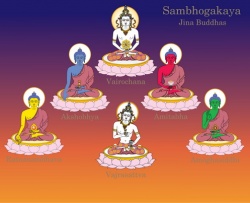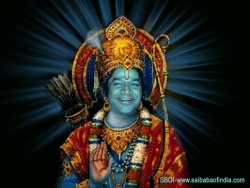The concept “self” and “person” in Buddhism and in western psychology
By DAVID GALIN
Langley Porter Neuropsychiatric Institute
University Of California, San Francisco
1) The goal of this collection of essays is to deepen the dialogue between Buddhism and Western science, two very different systems of thought, by focussing on areas where their core concerns intersect.[1] The concept of self is certainly at their core, pervading daily life and theoretical writings for millennia. Yet for both systems, self remains problematic; there is much confusion over exactly what self means, for ordinary folk and for the academics and professionals who are supposed to be experts on it. Thus, self is a promising meeting area to explore.
2) I am writing as a neuropsychologist, without formal credentials in philosophy or religious studies. Caveat lector! But these three disciplines are entwined from the roots to the distal twigs, and a serious student must venture into the thicket; it is difficult to stay within disciplinary boundaries. Also, I acknowledge the limitations of conceptual efforts to treat what many believe to be beyond concepts, beyond self/object and self/other; this essay is for those who want to explore whatever may be possible within these limits.
3) My purpose here is to map the relations and disjunctions between Western psychology and what I understand of the Buddhist concept of self, or more properly, of “no-self” (anatta). The idea of “no self” is counter-intuitive to most Westerners. I believe there is a key point at which we can make contact and begin mapping. Buddhist tradition holds that the root cause of suffering is the Ordinary Man’s erroneous view of self as an unchanging essence. Futhermore, the tradition holds that this error is inevitable in the natural course of life because it is based on inborn patterns, pre-theoretic and unreasoned (e.g.,Garfield, 1995, p. 88). It is this “erroneous” view of self that is the focus of this essay. I propose that the Western perspectives of cognitive neuropsychology and adaptive evolution may add to Buddhist understanding of the inborn view of self, and of how the “correct” view is attained.
4) I will introduce the idea that person, self, and “I” are not synonymous, but are quite different things, with person including more than self, and self including more than “I”. Because I am proposing extensive changes to Western concepts and terms, I will present at length some of the current confusions and controversies that illustrate how the old concepts are inadequate. Then I will highlight two cognitive perspectives that reveal mechanisms by which the natural, pre-theoretic, view of person and self operates. The first concerns the recognition that metaphor plays an enormous role in abstract thought, and in particular, in our thinking about person, self, and “I”. The second concerns the human tendency to seek and find, or project, a simplifying pattern to approximate every complex field. We simplify in two nonconscious automatic ways: by lumping (ignoring some distinctions as negligible), and by splitting (ignoring some relations as negligible). Splitting into discrete entities is useful for manipulating, predicting, and controlling at the sensori-motor level, and at abstract levels too. Unfortunately, splitting can lead to serious errors when it imposes ad hoc boundaries on what are actually densely interconnected systems, and then grants autonomous existence to the segments it has created. This occurs in our experience of our own “inner life”, and in our concepts of the structure of “the person”. Thus we come to see the self as a bounded persisting entity, rather than as a dynamic open network of relations. I will argue that the view of self as entity or essence is maintained so strongly because it is rooted in these basic nonconscious cognitive approximations. However, the other side of our pattern seeking, which simplifies by lumping (unifying, finding more relatedness), can be corrective to the creating of isolated entities by splitting. I will suggest that this second type of approximation may be the seed of the Buddhist “correct” view that all things are interdependent. Perhaps these Western ideas could add to Buddhist understanding of the difficulty of transforming the inborn view of self and person.
1. THE BUDDHIST CONCEPT OF NO-SELF (“ANATTA”)
5) I will sketch my understanding of the generic Buddhist view for those with little familiarity with Buddhism, drawing heavily on Collins (1982), Garfield (1995), Hopkins (1983; 1987), and Wallace (1989; 1998). In the Buddhist “correct view”, the Self is seen, not as an entity, or as substance, or as essence, but as a dynamic process, a shifting web of relations among evanescent aspects of the person, such as perceptions, ideas, and desires. The Self is only misperceived as a fixed entity because of the distortions of the human point of view. Ultimately, no separation is to be found between these dynamic processes and the universal frame of reference or ground of being; all is interdependent and changing. Thus, in this sense, there is no Self separable from a Non-self. This Buddhist declaration is misunderstood in the West because “anatta” meaning self-is-not-an-essence-or-entity, is taken as self-does-not-exist-at-all by people who have not imagined any other scheme of existence than entities or essences[2].
6) The Buddhist tradition holds that Ordinary Man’s inborn erroneous view of self as an enduring entity is the cause of his suffering because he tries to hold on to that which is in constant flux and has no existence outside of shifting contexts. Therefore, a new corrective experience of self is needed. Buddhism takes a great interest in how people experience their self, rather than just their abstract concept of it, because Buddhist practices are designed to lead to a new (correct) experience of self. It takes arduous training to modify or overcome the natural state of experiencing the self as persisting and unchanging. There is a great literature on the theory and practice of the three main paths leading to a changed experience of self. One path is via meditation trainings (changing mind processes or mind controls, e.g., attention, awareness, arousal). Another is via theoretical argument (changing structure of concepts, the contents of mind). The third path is social-behavioral, the life of active service (Deikman, 1996; 1997; 2000). The three paths of meditation, scholarly study, and service in the monkhood or wider community, are usually intertwined in practice.
7) My limited understanding of this enormous tradition has been very much shaped by Garfield’s exposition of Nagarjuna’s Mulamadhyamakakarika (1995), and by Collins’ book, Selfless Persons (1982). Collins seeks to explicate the doctrine of “No-self”(anatta) in social and historical contexts, as well as its usual religious (soteriological) and philosophical roles. Although he draws mainly on Theravada illustrations, his broader conceptual framework enables him to bring out the features of the “No-self” view that apply to any Buddhist culture, despite the differences among Theravada, Mahayana, and many other schools that formed through theoretical development, schisms, and assimilation into diverse cultures over 2500 years. To stress the centrality of this doctrine he quotes three quite different contemporary scholars:
8) Rahula (1967): What in general is suggested by Soul, Self, Ego, or to use the Sanskrit expression Atman, is that in man there is a permanent, everlasting and absolute entity, which is the unchanging substance behind the phenomenal changing world. ... This soul or self in man is the thinker of thoughts, feeler of sensations, and receiver of rewards and punishments for all its actions good or bad. Such a conception is called the idea of self. ... Buddhism stands unique in the history of human thought in denying the existence of such a Soul, Self, or Atman. ... to this false view can be traced all the evil in the world.
9) Malalasekera (1957): ...in its denial of any real permanent Soul or Self, Buddhism stands alone. This teaching presents the utmost difficulty to many people and often provokes even violent antagonism towards the whole religion. .... yet it is the bedrock of Buddhism.
10) Nyanatiloka (1964): There are three teachers... the first teaches the existence of an eternal ego-identity outlasting death (the Eternalist). The second teaches temporary ego-entity... annihilated at death (the Annihilationist, Materialist). The third is Buddha, teaching... there is only to be found ... changing from moment to moment, ... egolessness of existence. ... Thus with this doctrine of egolessness, or anatta, stands or falls the entire Buddhist structure.
11) This doctrine of No-self has major theoretical implications for two other central components of Buddhist doctrine; Karma, and Rebirth. With not even a temporary self, how can we understand the apparent continuity and coherence of personality in the present life? Without a permanent self, just what is reborn in another life? If there is no self, to whom or to what does Karmic ethical responsibility belong, and to whom or to what is it transferred in a later life? These issues are beyond the scope of this essay (see Garfield 1995; Collins 1982). But anatta raises other issues, more pragmatic than theoretical or doctrinal: how can the seeker go about developing “right views” of self and person, particularly since the erroneous view is held to be inborn and pretheoretic, particularly resistant to rational discourse or scholarly philosophical argument. Buddhist schools differ in their beliefs as to the effectiveness of simply quieting the mind and introspecting, vs. developing intense and continuous attention, vs. non-rational dialogue and interaction, vs. directing introspection with rational analysis and conceptual framing (e.g., Japanese Soto and Rinzai Zen, Indo-Tibetan Vaibhasika and Prasangika). My examination of the inborn views from the Western cognitive neuropsychology point of view may suggest new ways to look at Buddhist practices.
2. IN WESTERN PSYCHOLOGY: MULTIPLE CONCEPTIONS OF SELF.
12) To the Ordinary Man in Western cultures, as in Buddhist cultures, the question, “What is a self?” may seem trivial; it is casually believed that every person has one, or is one, and that it is the self which acts or experiences. “Normal” folks have a vivid sense of themselves as distinct from not-self, from objects, or other selves, and most importantly, as single, unitary. Two elegant statements of this sense of unity in the Ordinary view are quoted (in order to refute them) by Joseph Bogen, the neurosurgeon-scholar most knowledgeable about separating the two hemispheres of the human brain, in his papers on the unrecognized disunity in normal people (Bogen, 1986; 1990):
13) Sherrington (1947): “This self is a unity ... it regards itself as one, others treat it as one. It is addressed as one, by a name to which it answers. The Law and the State schedule it as one. It and they identify it with a body which is considered by it and them to belong to it integrally. In short, unchallenged and unargued conviction assumes it to be one. The logic of grammar endorses this by a pronoun in the singular. All its diversity is merged in oneness.”
14) Descartes (cited in Bogen 1986): “There is a great difference between the mind and the body, in that the body is, by its nature, always divisible, and the mind wholly indivisible. For in fact, when I contemplate it - that is, when I contemplate my own self - and consider myself as a thing that thinks, I cannot discover in myself any parts, but I clearly know that I am a thing absolutely one and complete.”
15) Consider the possessives, me and mine. “Me” seems to refer to self, and “mine” seems to refer to objects: my car, my hair, my hand, my thoughts, my intentions, my mind. But the boundary is not clear. While “my car”, “my hair,” and “my hand” are all treated equivalently in syntax as "mine", most people feel that their hair is a more substantive part of "me" than their car, and their hand or mind more so than their hair. Furthermore, they believe that if they were to lose their hand their self would remain, that their essential nature as an entity would not be diminished. William James referred to this as “the self of all selves” (p. 297 James, 1950 (Originally published1890).).
16) Thus the question arises, “Are there degrees of self?” When we speak of self-development do we mean that there was a little self before and now there is more self? Or that there was qualitative change? If self varies in amount or quality, how do we measure these dimensions? Indeed, what sort of losses do we have to sustain to experience a diminishment of self, or for others to recognize it? And what do we mean when we say "I just don't feel myself today"? If there is a difference between how you usually feel and how you feel today, does that mean that there is a qualitative difference in selves? Is the difference substantive or just a trivial difference in appendages to the self, like a coat or a hairdo? When a psychiatric patient says "I do not feel like it is me" or hears his own thoughts but perceives them as external voices, is that qualitatively different? Apparently, the concept is not clear. The idea of self is elusive; lay people are surprised that they cannot easily articulate it. But their conception of self as an entity, and as unchanging for life or even beyond, is not really shaken.
17) Professionals in psychology and its neighbor disciplines (cognitive science, philosophy of mind, psychiatry, behavioral neurology) are no more coherent about self than lay people. When I have asked psychologist friends for their definition, many of them narrowed their eyes as if suspecting a trick question. Although there seems to be a general implicit endorsement that a person is in some sense “a whole”, just what makes up this wholeness is rarely addressed, and the self is not explicitly studied in relation to wholeness. Sometimes the professionals use the term self synonymously with self-concept, with self-awareness, with consciousness itself, and with volition. Sometimes it is used in the sense of personality, or social roles. Different disciplines have focused on different aspects of self; the literature is voluminous. To mention just a few exemplars whose models of self have little in common--- in psychiatry: Janet (1907), Freud and followers (1953), Jung and followers (1966), Mahler (1975), Kohut (1978), Deikman (1982); ….. It is the same in personality theory: Allport (1968), Lewin (1936), Maslow (1971); ….. and in social psychology: G. H. Mead (1962), Goffman (1959), Markus (1991). In “Western” philosophy, of course, there are too many to cite; to illustrate this overabundance, I will only mention that over the last year and a half the Journal of Consciousness Studies, the currently most popular journal bridging philosophy of mind and other humanities and sciences, has published a series on “The Self”, featuring a lead article by Strawson of Oxford, and four special issues of discussion and rebuttal to his keynote paper (Strawson, 1997). At the end of this series Strawson (1999) sums up, and attempts to clarify; “The result was a festival of misunderstanding... Large differences in methodological and terminological habits gave rise to many occasions on which commentators thought they had disagreed with me although they had in fact changed the subject.” See Parfit (1984) for a review of the past centuries’ Western philosophical literature on person and self.
18) In contrast to this plethora, the technical literatures of neurology, cognitive psychology, or neuropsychology show only sporadic concern with self, or with the wholeness of a person: e.g., Wm. James (1890/1950), Kurt Goldstein (1939), R. W. Sperry and his colleagues Bogen, Gazzaniga, and Zaidel (1969), E. Hilgard (1977), O. Sacks (1973), J. Kihlstrom (1993; 1997), and too few others. A few exceptions do stand out in neurology. In the last generation, Kurt Goldstein insisted on the importance of the organization of the whole person in determining the symptom picture (1939). In the present generation, Oliver Sacks has called for a less mechanical neurology which pays attention to "the center, the living self, of the patients", in his books Awakenings (1973), and The Man Who Mistook His Wife for a Hat (1985). In A Leg to Stand On (1984), Sacks has movingly described how a neurologist can be oblivious to a patient's complaint about disturbance of self or wholeness (following an accident, Sacks as the patient could not recognize his own leg as his). Even if a neurologist does take such a symptom seriously, he is likely to refer the patient to a psychiatrist unless he believes that neurological knowledge has something to contribute to the understanding or the care of such patients.
19) Some dramatic examples from pathology have become well known to the public. From psychopathology there have been popular movies and books about multiple personalities such as Three Faces of Eve, and Sybil, who had 17 distinct "selves." From neuropathology there has been much publicity about the "split-brain" patients whose cerebral hemispheres have been surgically disconnected. After the surgery, each hemisphere is separately conscious, and can perceive, learn, and remember, without knowing what the other hemisphere is experiencing. Nevertheless, both the patient and the patient's family report that they seem to be as much "themselves" as ever (Sperry, 1968) (Sperry et al., 1969) (Sperry, Zaidel, & Zaidel, 1979).
20) The studies of the split-brain patients by Sperry, Bogen, and their colleagues demonstrate how interconnections at the neurological level contribute to the wholeness at the psychological level . To understand these observations it must be remembered that each hemisphere controls feeling and movement only on the opposite side of the body, and sees only the opposite half of visual space. Only the left can talk. One of their dramatic films records a patient trying to match a colored design with a set of painted blocks. The film shows the left hand quickly carrying out the task; the left hand is controlled by the right hemisphere which is good at spatial relations. Then the experimenter disarranges the blocks and the right hand (left hemisphere, poorer at spatial relations) is given the same task. Slowly and with great apparent indecision it arranges the pieces. In trying to match a corner of the design, the right hand corrects one of the blocks, and then shifts it again, apparently not realizing that it was correct: the viewer sees the left hand dart out, grab the block and restore it to the correct position... and then the arm of the experimenter is seen, reaching over to pull the intruding left hand off-camera. The left hand repeatedly tries to intrude and the experimenter finally makes the patient sit on the left hand while the right hand continues trying to arrange the blocks.
21) In another experiment, a picture is shown to one hemisphere and the patient is asked to point to a matching object in a row of objects before him. Both hemispheres can see the objects; only one was shown the picture. In one case when the picture was shown to the right hemisphere and it pointed to the correct object, the left (speech) hemisphere said, "I know it wasn't me that did that!"
22) In these incidents, just who are the "persons" involved? What has become of the apparently unified self that existed before the surgery? Is it now two, or was it always two, but now the duality has been made obvious? Until now the language of Western psychology has been too fuzzy even to formulate these questions clearly, and there has been no consensus on a model which will describe the "I" who knows that "me" did not do it, and who did do it. Furthermore, we need to account for the testimonies of the patients that their experience of Self has not changed. We also need to account for such phenomena as they occur in "normal" people (Bogen, 1986; 1990) (1974; Galin, 1977) (Galin, Johnstone, Nakell, & Herron, 1979). Our present theories of self do not address such phenomena.
23) Now I will turn to another window on the panorama of confusion and apparent paradox that pervades Western thinking about self and person. This is a large body of research and theory by cognitive linguists on our largely nonconscious intuitions of the structure of our “inner life”
3. Cognitive Linguistics Theory of Metaphor, and the Folk-Model of Person, Self, and “I”
24) Over the last twenty years, cognitive psychologists and linguists have carried out paradigm-busting work with powerful implications for all of psychology. They show that metaphor is fundamental to nearly all of abstract thinking. Many contributors could be cited; even a partial list would include Mark Turner, L. Talmy, E. Sweetser, E. Rosch, T. Regier, A. Ortony, G. Nunez, S. Narayanan, G. Lakoff, A. Lakoff, Mark Johnson, D.Gentner, J. Grady, R. Gibbs, G. Fauconnier, C. Brugman, D. Bailey. Representative citations for these authors can be found in two influential books, Fire, Women, and Dangerous things, (Lakoff, 1987) and Philosophy in the Flesh, (Lakoff & Johnson, 1999), which summarize much of this research and theory. What concerns us here is their conclusions about the underlying cognitive structure of ordinary people’s concepts of person, self, and “I”. Understanding how metaphor normally works in thought explains much that seems incoherent in common and professional talk and thinking about person and self. Lakoff and Johnson’s analysis of common speech uncovers a nonconscious complex system of a dozen metaphors, many incompatible with the others, and quite different from the consciously reported notion of self as unitary, unchanging, and essential, like a soul.
3a. How metaphor works
25) We are not aware of how much of our thinking is based on metaphor, even in science (e.g., in the concepts of number, time, force, and category). Metaphor is the basis of reasoning by analogy. It gives our thinking enormous power, because we can extend our knowledge of the complex relations in a concrete domain to an abstract domain (e.g., thinking of a love relationship as like a journey, thinking of numbers as like positions on a line). For example, consider our commonly repeated physical life experiences with moving on a path from start to end. We learn certain “logical entailments” that are true of paths, such as that going from start to end entails passing through all the other points on the path. Thus if love is a journey, we will have to pass through a series of stages on the way to the destination. But analogies fit only partially; love is not only like a journey, but also like a rose, and like an invincible conqueror; numbers are not only like positions on a line, but also like collections of objects, and like containers that hold collections. Therefore our metaphors break down if stretched too far from the original context, and must be replaced (usually unconsciously) by new ones, more apt for the new context. Because we are not aware of how much of our thinking is based on metaphor, we are peculiarly prone to take our metaphors literally. Taking metaphors literally can have very serious effects, as when we take teaching stories and fables as historical. Lakoff and Johnson assert that many conflicts among the various schools of Western philosophy from the Greeks onward can be understood by mapping the metaphors which underlay their reasoning, and grasping that each philosopher unconsciously reified his metaphor and then insisted it was the “true reality”, i.e., always apt, independent of context (Lakoff and Johnson 1999).
3b. LAKOFF AND JOHNSON ON PERSON, SELF, AND “I”
26) Limitations on space allow only a too condensed overview of this complex body of data and theory. The material in this section is almost all quoted or paraphrased from Philosophy in the Flesh (Lakoff and Johnson 1999).
27) Our “inner life” includes a variety of experiences that we want to refer to:
· conflicts between our conscious values and the values implicit in our behavior.
· inner dialog and inner monitoring.
· disparities between what we know or believe about ourselves and what other people know or believe about us.
· controlling our bodies, and ways in which they "get out of control."
· taking an external viewpoint, imitating someone, or trying to see the world as they do.
28) It is quite surprising that, although these types of experience are so commonplace that they may be universal, we do not have any single way of conceptualizing inner life that covers all these cases. But what is most surprising is that we have a system of inconsistent metaphorical conceptions of our internal structure, drawn from different experiential domains: space, possession, force, and social relationships. The same system of metaphors occurs in at least one case of a very different non-Western language and culture: Japanese. Furthermore, when we examine these metaphors, we find that several terms for ourselves as persons with “inner lives” which we thought were synonymous (self, “I”, me, myself) are not synonymous at all. Nevertheless, people seem to have no difficulty intuitively understanding these metaphor systems and switching among them.
3c. THE GENERAL “DIVIDED PERSON” METAPHOR
29) “It is not a trivial fact that every metaphor we have for our inner life is a special case of a single general schema. This schema reveals not only something deep about our conceptual systems, but also something deep about our inner experience, mainly that we experience ourselves as split” (Lakoff and Johnson 1999 p. 269)[3].
30) According to this unconscious schema, a person is divided into an “I” and one or more Selves. The “I” is that aspect of a person that is the experiencing consciousness (the subject) and by its nature, exists only in the present. It is always conceptualized as a human-like being and is usually but not always the locus of reason, values, and from which will is exercised (the agent), although acts must be carried out by one of the selves.
31) A Self includes those parts of a person not picked out by the “I”, such as the body, social roles, past and future states, and actions in the world. There can be more than one Self. Unlike the “I”, each self can be conceptualized metaphorically as an object, or a location, as well as a human-like being.
32) The general schema, then, contains a human-like being (the conscious “I”), one or more entities (one or more Selves), and a specification of who is in control and who judges whom. There are many specific varieties of the general metaphor, grounded in types of everyday experience such as: (1) manipulating objects, (2) being located in space, (3) entering into social relations, and (4) empathic projection (taking other points of view). There is another important variety derived from the Folk Theory of Essence: Each person is seen as having an “essence” that is part of the “I”. The person may have more than one Self, but only one of those Selves is compatible with their essence. This is called the “real” or “true” Self. All these variations give rise to the extraordinary richness of our metaphoric conceptions of our “inner life”.
33) I will give illustrative examples of only a sample of the various metaphoric types. Please note that in spite of their apparent ambiguity, these sentences are all immediately understood in common speech.
34) Me And Myself Are Not Always Synonyms: notice the difference in meaning of these two sentences:
a.) If I were you I’d hate me.
b.) If I were you I’d hate myself.
In a.), me refers to the Subject(“I”) of the speaker; in b.), myself refers to a self of “you”, the person addressed.
35) Judgment: sometimes the locus of judgment is the “I” and sometimes it is the self. Compare these:
a) I was disappointed in myself.
b) I disappointed myself.
36) Self-Control Expressed As Control Of Objects : Holding onto and manipulating physical objects is one of the things we learn earliest and do the most. It should not be surprising that object control is the basis one of the most fundamental metaphors for our inner life. When the self is seen as a physical object, control means possessing it, or moving it:
Control as forced movement:
I held myself back; I dropped my voice; You’re pushing yourself too hard; I’ve got to get myself moving on this project.
Control as Possession of an Object: Losing control can be positive as in b), or negative, as in c) :
a.) I got a grip on myself. I didn’t let myself wiggle out of that.
b.) I let myself go, and lost myself in dancing.
c.) I was seized by anxiety, carried away by fear. I was possessed by Demon Rum.
37) Self-Control and Location: When self is seen as a location in space, self-control can be expressed as the “I” and the self being together at the same usual place, or inside the usual contained space, such as the body, home, or on earth. Loss of self-control is expressed as the “I” or the self being out of the usual place, or separated:
· I did not get high; I kept centered: I feel well-grounded.
· I was beside myself; ecstasy; out of my head: out to lunch: off in space:
· I was scattered: I must get myself together: He is all over the place.
38) Other Relationships of “I” and Selves: When the self is seen as another human-like being, many other relationships than control can be entered. This permits a remarkable metaphoric richness, mapping our knowledge about specific social relationships onto our inner lives. For example: master-servant, parent-child, friends, lovers, adversaries, interlocutors, advisors, caretakers.
39) The “I” and Self As Adversaries:
I am at war with myself over who to marry. I am struggling with myself. He's conflicted. He’s giving himself a hard time. Why do you torture yourself; being so mean to yourself; just making yourself suffer. He’s his own worst enemy.
40) “I” As Parent; Self As Child:
I weaned myself from whiskey. She pampers herself a bit too much; You've earned the right to baby yourself. We all need to nurture ourselves. I'll reward myself with an ice cream. Everyone needs to mother himself now and then.
41) “I” and Self As Friends:
I'll just hang out with myself tonight. I like being with myself. I need to be a better friend to myself.
42) “I” and Self as Interlocutors:
I debate things with myself all the time. I talk things over with myself before I do anything important.. I convinced myself to stay home.
43) “I” As Caretaker of Self:
You need to be kind to yourself. I promised myself a vacation. He nursed himself back to health.
44) “I” as Master; Self As Servant:
I have to get myself to do the laundry. I told myself to prepare. I bawled myself out for being impolite. I'm disappointed in myself.
45) The “I” Is Obligated To Meet The Standards Of The Self:
I have a responsibility to myself to exercise. Don't betray yourself. Be true to yourself. I let myself down. I disappointed myself.
3d. The Essential Self
46) Lakoff and Johnson find another important set of metaphors based not on near-universal perceptual-motor experiences, but rather on a near-universally held belief system (what they call a Folk Theory; whether such theories are embedded in the culture or are inborn “Kantian categories” is not relevant to the present issues). According to the Folk Theory of Essence, every object has an Essence that makes it the kind of thing it is and that is the causal source of its natural behavior. This applies to human beings: each has an essence that makes him unique, that makes him him. It is the essence that makes one behave like himself and not like somebody else. (It was this same Folk Theory that was formalized by Plato, and others. Lakoff and Johnson expose the metaphoric foundations of the idea of essence itself in Philosophy in the Flesh).
47) “We have in our conceptual systems a very general metaphor in which your Essence is part of your Subject (the “I” ) —the locus of your consciousness, thought, judgment, and will. ...it is your Essence that, ideally, should determine your natural behavior. However, our concept of who we essentially are is often incompatible with what we actually do. This incompatibility {is dealt with in} the Essential Self metaphor. There are two of these Selves. One Self (the “real” or “true” Self) is compatible with one’s Essence and is always conceptualized as a person. The second Self (not the “real” or “true” Self) is incompatible with one’s Essence and is conceptualized as either a person or a container that the first Self hides inside of.” (p. 282)
48) Here are examples of three versions of the Essential Self Metaphor system:The Inner Self: In this case, Self 1 (the Real Self), is Hidden inside Self 2 (The Outer Self), because, as in a.), it is fragile and shy, or because as in b.), it is awful and doesn’t want anyone to know it is there, or both.
a.) He won't reveal himself to strangers. She rarely shows her real self. Whenever anyone challenges him, he retreats into his shell to protect himself.
b.) Her sophistication is a facade. He is embarrassed to reveal his inner self. She's sweet on the outside and mean on the inside. The iron hand in the velvet glove. His petty self came out.
The Real Me: In this case, Self 1, the Real Self, who is quite nice, is outside and public, and Self 2, who is awful in some way, is hidden inside. But when The Real Self lets its guard down the awful Self comes out:
· I'm not myself today.
· That wasn't the real me yesterday.
· That wasn't my real self talking.
The True Self: In this case, throughout life, the “I” has been inhabiting Self 2 which is incompatible with The “I” ’s Essence. Self 1, which is compatible with the “I” ’s Essence is somewhere unknown and the “I” is trying to find his “true” Self, the one compatible with his Essence, with who he really is.
49) Very little research has been done on the metaphoric systems of inner life in other languages and cultures towards establishing whether there are universal experiences of inner life. Lakoff and Johnson originally believed that this metaphor system for the inner structure of the person was a peculiarity of either English or the Western mind. But a Japanese linguist pointed out Japanese examples that both look like, and are understood in the same way as the English (see Lakoff and Johnson pp. 284-287). Anthropologists and social psychologists have written extensively on the differences between the Western and Japanese conceptions of Self, but what seems to be radically different is the Japanese conception of the proper relationship between self and other. Japanese conception of the architecture of inner life appears remarkably like the American one, according to the clues we do have from their metaphor systems and the way they reason and act using those metaphor systems. However, much work remains to be done to justify generalizing from the English or Western to “universal”.
50) In Summary: Can this analysis of metaphoric concepts tell us anything about what our inner lives are really like? I emphasize that it does not mean that we are literally divided up at a neurological or microcognitive level into a “I” and one or more selves, or into essences. But these metaphors do seem to capture much of the qualitative feel of inner life. When we use them to make statements like, “I’m struggling with myself over whom to marry,” or “I lost myself in dancing,” or “I wasn’t myself yesterday”, these statements ring true to us. These metaphoric structures seem apt because they conform in a significant way to the phenomenological structure of our inner lives, and capture its logic and how we reason about it.
51) Lakoff and Johnson conclude:
“What is philosophically important is that there is no single, unified notion of our inner lives, not one “I”-Self distinction, but many.... all metaphorical, {that} cannot be reduced to any consistent literal conception... Far from being arbitrary, {they} express apparently universal experiences of an “inner life” ... in metaphors grounded in other apparently universal experiences. These metaphors appear to be unavoidable, arising naturally from common experience.” ... (p. 268).
4. SOME PROPOSED CLARIFICATIONS: PERSON, SELF, “I”, SELF-MONITOR, SELF-AWARENESS, SELF-CONCEPT.
52) I have presented this review of confusion and controversy in Western notions of the self in order to justify my call for some radical changes in the way professionals talk and think about these matters. It is necessary for professionals to go beyond the unconscious metaphors of common speech, and the parochial formalizations of the metaphors by particular philosophical or psychological schools. This is not just scholastic word-play; terms are tools. A relatively easy first step is to sharpen our terms, taking care to preserve the insights into structure and function that these metaphors and intuitions are built on. The concept person can be distinguished from the concept self, and self can be separated from hyphenated derivatives with which it is often conflated or confused: self-monitoring, self-concept, and self-awareness. The concept “I” can be distinguished from self and from person.
53) I propose these definitions heuristically, without any pretension to rigor for the time being. The purpose here is to arrive at a set of terms consonant with the broad “scientific” frame of reference, and in particular, commensurable with the dimensions of the cognitive sciences and contemporary philosophy of mind. Rather than inventing totally new terms or definitions for the tangled old concepts, I am trying to select and highlight the most important meanings already present. Thus I believe that what I am proposing is not only internally consistent, but consistent with the intent of the most common usages. Well-wishers have advised me that my plan is hopeless, because people are extraordinarly resistent to changing their terms. Nevertheless, the need makes the gamble worth while. I ask the reader to read this section through, inhibiting the “Yes, but...” reflex, and perhaps she will find her objections handled a bit further on.
4a. Person and self
A person is a complex system, made up of component subsystems. Person is, in principle, the entire self-organizing[4], multilevel, causal thicket[5], including bodily, mental, and social aspects, and representations of past and future organizations (selves). This list is meant to be open-ended, and other dimensions can be added as needed. Person, of course, is embedded in a larger complex environment (the universe). My new incudes all of these, always. It contrasts with common usage, in which just how much is included by person and personal always depends on the speakers’ conventions and on their purposes. Thus, under the common definitions, sometimes person refers to the body (“touched his person), sometimes to intimate feelings (“religion is too personal”), and sometimes to social relations (“separate personal and professional life”). Since this is not made explicit in ordinary discourse, it contributes to the confusion.
54) Our common speech sometimes distinguishes between person and self, but with multiple, context-dependent senses, as illustrated by Lakoff and Johnson’s observations presented above. I propose that we formally designate that person is extended over time, and self is the current organization of the person. That is, self is the way all of the subsystems of the person are related to each other. I emphasize that self is a characteristic of the person as a whole, rather than just another subsystem or constituent as some psychological models would have it. In discussing the complex we call person it is very useful to be able to refer to its organization (self) in contrast to its instantiation (embodiment). Organization is simply the set of all the relations among the constituents of the system. This can include such relations as membership, connection, and control.
55) It is readily apparent that a person, like any complex system, might be capable of several different patterns of organization (selves). For example, it may be tightly organized, with all subsystems integrated, so that the activity of each part is always affected by the state of all of the parts. Another system may be more loosely integrated so that some subsystems may function semiautonomously, within broad limits. A third pattern of organization might have some subsystems tightly integrated, acting like clusters, but only loosely coupled to other subsystems or clusters. This sort of description applies, no matter what sort of subsystems one is concerned with. A cognitive psychologist for example, might be concerned with the connections and control relations between the memory subsystem and the emotion subsystem; under some organizations memory may function largely independent of mood, and under other organizations might be greatly affected. To take an example from social personality theory, occupational behaviors may or may not be affected by drastic changes in family life (marriage, divorce). Defining the self as the pattern of organization emphasizes that it changes over time; over a period of years, as in the maturation of adolescence, or over minutes, as in multiple personality disorders. By defining self as the organization of subsystems rather than as just another subsystem, we get a clear referent for common phrases such as "a more integrated self," or "a development of the self," or "a loss of self." The concept of self as organization, varying dynamically in degree and quality, works at the neurological level of description as well as at the psychological level, and across levels.
4b. HYPHENATED DERIVATIVES OF SELF
56) Self-monitor: Many complex self-regulating systems that adapt to their environment use a regularly up-dated map of their own state and the adaptations made. The processes that keep track of the current state of the self in its environment are likely to be hierarchically organized and distributed over many levels, but for simplicity I use the term self-monitor in the singular to refer to all of them collectively.
57) We infer the existence of a self-monitor because we know a lot about our present "mode" of organization, including such things as the level and quality of our awareness and our cognition, and our status as agent. For example, we know how aroused we are (drowsy or alert or drunk); we can distinguish imagining from remembering, we can even sometimes realize that we are dreaming and not awake. We have information about our goals and actions; when the doctor taps our knee and elicits a reflex knee-jerk, we can say "I didn't do that," or "I don't feel like myself today."
58) However, this monitoring subsystem is not the self; it is a subsystem among many others. Like any other map, it can be incomplete, or wrong. It remains to be learned what its inputs are, what aspects of organization it can monitor and what it cannot, what sort of errors it can make, how it can be turned on and off, how its functioning varies from time to time or from person to person. The idea of self-monitor as distinct from self and self-concept is useful in thinking about phenomena such as hypnosis and hallucinations, and how the left and right cerebral hemispheres relate to each other. In previous papers I have discussed self and self-monitoring in the context of unawareness of deficits following certain brain injuries (Galin, 1992), and how one of the types of information present in awareness can serve a self-monitoring role (Galin 1994).
59) Self-awareness: Please note than until this point, awareness (consciousness) has not had to be mentioned in any of the definitions. It must be considered here, and in discussing the experience of “I”, but beyond that I intend to finesse, by referring to previous essays which discuss in detail the structure of awareness, and what kind of a thing awareness may be ( Galin 1994, 1999)
60) Self is often treated as synonymous with awareness, or even with just self-awareness alone. Logically, self-awareness means simply awareness of some information about the self (Galin, 1992). Since I have defined self as the organization of the person, it follows that self-awareness means awareness of some aspect of that organization. Only a small part of the results of self-monitoring or self-concept ever enters awareness. This should not be surprising; numerous experiments have demonstrated that even very complex information processing can go on without our being aware of it (Kihlstrom, 1987) (Velmans, 1991). Specialized modules of our sensory-perceptual systems continuously acquire knowledge of the world, and elaborate, evaluate, and incorporate it into plans and actions, and only the final product appears in consciousness. At present, cognitive neuroscience has only the most general hypotheses as to what sort of additional process or factor is required to bring any content into consciousness. We will return to self-awareness below when we consider what “I” means.
61) Self-concept: The self-concept can be thought of as a body of information consisting of knowledge, beliefs, attitudes, etc. about "who or what one is" as an entity in the world. The self-concept refers to the self, but is just a subsystem. It is similar in form to our concepts of any other objects, e.g., our next-door neighbor or the Washington Monument. Like any other concept we have, it can be incomplete and in some respects incorrect. Some of it must come from the self-monitor, but much of it comes from other sources, such as the opinions of our relatives. As we shall see below, we can have many, even contradictory self-concepts. Like any other concept, it can be brought into consciousness from time to time, but it is clearly distinguishable from self, from self-awareness in general, and from self-monitoring of current states as defined above.
4c. THE “I”: ENTITY, KNOWLEGE, AND POINT OF VIEW
62) The new idea here is in answer to the question, “what kind of a thing is the ‘I’?” To develop this account, it is first necessary to define three other common but uncommonly difficult terms: entity, knowledge, and point of view. The first-person point of view in particular is a surprisingly subtle concept. In a recent paper (Galin 1999) I have discussed at length how first-personness has two senses, point of view and consciousness, which are confused in Western philosophy and psychology. For our present purpose, however, I will just set these three definitions as a foundation, and then go on to propose that “I” is a kind of perspective, or point of view. It is the perspective or point of view of the system person, given by its present organization (self).
63) Entity: This is the key concept, whose meaning is almost always mistakenly assumed to be naturally given and intuitively obvious. An entity (a unit, a wholeness) is a group of bits or elements distinguished from those in its environment by “belonging to each other” in some sense. It is the relationships between the elements that make it an entity, not an edge, shell, skin, or border that separates them from their neighbors. The pattern of relationships among the elements creates an implicit or virtual border. According to the analyses of Simon (1969 p. 209 ff.), and of Wimsatt (1974, and 1976 pp. 242, 261), we call a set of parts an entity if there is sufficient inter-relatedness among them[6]. “Sufficient” is decided by some criterion chosen for our purpose. Functional relations, spatial and temporal relations, social relations, are examples of aspects by which we commonly decide that some distribution is an entity or not. For example, a group of people is an entity we call “family” if the people have sufficiently close relations; whether or not we set the criterion to include second cousins, adoptees, steps, and pets, or only parents and their natural children depends on our purposes. Thus, entiticity is a matter of convention as well as a matter of degree. In general an entity does not have a sharp boundary. It depends on the relative amount of inter-relatedness of its components (nothing in a universe has no relation to anything else). I believe this greatly softens, but does not quite extinguish, the usual hard self/object boundary, which has been such a contentious point in Western and Buddhist metaphysics and psychology.
64) I stress the rather surprising conditionality of entities because properties such as point of view, or knowledge, or consciousness belong to a specific entity, and to understand the property we must be clear about just what we think constitutes the entity which hosts it. According to our usual view, an interaction occurs between two entities, and the conditionality I am highlighting, may make it difficult to specify or justify what we think are the entities involved. Problems arise when we forget that what we are treating as an entity is only more or less an entity, of limited duration, and only by agreement for the present purposes (e.g., a marriage, a corporation, the Republic of Congo). Many confusions about “person” and “self” arise here. Humans have a great passion for entifying; we frequently turn verbs and adjectives into nouns, and turn processes and relations into things.
65) Knowledge, To Know: The definition of this conceptual cluster has a very long history in philosophy and is currently used in many senses: to perceive directly[7], to be capable of, to be fixed in memory, to be acquainted or familiar with, to be able to distinguish (Webster’s dictionary). Note that none of these usages specifies consciousness; they all make sense for instances of nonconscious as well as for conscious knowings. The sense that best captures the phenomena that concern us here is one of the most general; to know is to be able to distinguish.
66) Know implies a knowing entity, and that which is known. For an entity to know something XYZ (to know how to XYZ, or to know that XYZ), is for it to distinguish XYZ from at least some not-XYZ, to act discriminatively toward XYZ. No consciousness is implied. The minimum discrimination is detection; something happened, or didn’t; something is, or isn’t. Knowledge is the capacity to discriminate, a potential to use information[8]. It is a functional property, and it does not imply time-coded and source-labeled memories or stand-alone representations in their common senses.
67) Point of view: The terms “point of view” and “perspective” are metaphors taken from the domain of visual-spatial perception and applied to the more general domain of knowing. These metaphors express the intuition that people operate within a frame of reference or coordinate system (analogous with a spatial coordinate system) made up from their repertoire of concepts. Much of the conceptual repertoire is quite abstract and not visual-spatial or sensory-perceptual at all. For example, we can speak of having a particular political, ethical, or pragmatic point of view. Thus point of view applies to domains such as values as well as to domains of spatial perception and action; an event or object is good or beautiful or moral from my point of view just as an object is above or below, or on the right or the left from my point of view. Note that as with the previous concepts, awareness (consciousness) is not required for a point of view (Galin 1999a).
68) Like knowledge, a point of view belongs to a specific entity. A point of view is the total set of possible discriminations that an entity can make in its present state, or over some period of time specified for our purpose. We are generally interested in dynamic systems (i.e., systems that change), and at any one time some of the knowledge that the entity has may not be available for use. For example, in an enzyme molecule the critical receptor region may be temporarily folded inside, unable to interact. Similarly, different capacities for discrimination may be available to you in the context of a street mob than in the context of your private study. Thus the point of view will vary as the properties of the entity are affected by the time, place, and other contexts of the entity.
4d. DEFINING The “I”, The SUBJECT, AND THE AGENT
69) With these definitions in hand, I propose that the “I” is a kind of point of view. It is the point of view of the entity person, given by the person’s present organization (its self). Thus, “I“ is not equivalent to self. “I” includes both the subject and agent. “Subject” is the input point of view, that is, the set of currently available discriminations from which perceptions are selected. “Agent” is the output point of view, the set of currently available discriminations from which actions are selected. [9] The psychological construct we call “the present” is a reference point in “real time” or “clock time” (time that changes in one direction, at a constant rate, for all entities). The self’s “I” must be in the present because the self’s perception and action machinery must use the same synchronizing reference point as the entities they perceive or act upon. For example, speech is severely disrupted if you hear your own voice through earphones with even a slight delay. I hypothesize that the process of adopting the “real time” point of view is the basis for what we call Subject and Agent. Subject and Agent can be lumped as a single entity named “I” because they both share the “real time” point of view.
70) Selves other than the current one are reference models (representations of possible states of self). They are either not in the present (like the past or future states of “I”), or not in real time at all, like the ideal self (what you should be like, but are not), the shadow self (what you should not be like, but are), the longed-for self (desired), the inner self (hidden from “I” or others), and the real or true selves (many meanings, contextual). These are best thought of as multiple self-concepts, named so that we can refer to the richness and contradictions of our physical, mental, and social life that cannot be denoted by the “I” anchored in clock time and action.
71) This multiplicity would confuse Aristotelian rationalists, but ordinary people do not notice any difficulty in the course of daily life. As Lakoff and Johnson have shown, in common speech the multiplicity is managed nonconsciously through the Divided Person metaphor, discussed above in Section 3c. Beware that my definitions, arrived at by analysis and for analytic purposes, are different from the nonconscious heuristics observed by Lakoff and Johnson. In that schema, the “I” is separate from the “Self or Selves”. Note that what the metaphor names as “I” includes much more than my subject-and-agent point of view. And what the metaphor names as “other selves” is what I have identified as “self-concepts”(see Sections 3c and 4b above). In what follows, I will stick to my terminology, developed for internal consistency.
72) It is critical to note that the “I” point of view includes only those discriminations made by the entity as such, not by one of its parts acting for the time autonomously and without relation to the entity as a whole. Consider for example, the knee-jerk reflex response that the doctor elicits by putting the knee joint in a relaxed posture and tapping on the knee-cap tendon. A person generally does not have a sense of agency about the leg movement, does not feel that “I did that”, and claims that the “leg” did that. In this posture the leg is less related to the rest of the person and thus is interpreted as acting as an entity on its own. In contrast, when the person is standing, the leg is integrated into the rest of the superordinate entity, and cannot be allowed to act autonomously; the reflex is much more difficult to elicit in this position. Thus we see that the feeling of agency claimed by “I” is associated with the superordinate entity person.
73) “I”-Awareness: The definitions developed thus far reveal a previously hidden conflation. “I” itself is not in awareness; it is a point of view, not a content. The point of view “I” is the total set of discriminations that could be brought to bear in the person’s interactions, not only the ones actually in operation at the moment, and certainly not only the few which the person may be aware of at the moment. Because of the limited channel capacity of awareness, rather little of the person’s total point of view could be in awareness at any moment. The part that does get into awareness can be called experience of “I”, or “I”-awareness.[10] Note that the term self-awareness must include more than just “I”-awareness; it should cover any of the experiences related to the self, such as feeling alert or sleepy, lonely or in love, healthy or sick, which do not refer to the point of view per se. Self, defined as the organization of all the subsystems of the person, includes much more than the person’s point of view.
74) The “I”(the point of view of the person) may be changed as the total organization (self) changes in response to the environment (e.g., if you see a police car in your rear-view mirror), or to changes within the person system itself (e.g., a high blood alcohol level). Notice that any particular changes in self may produce large or small changes in the set of discriminations that are available. Therefore, the “I” may change from moment to moment, or may stay relatively “the same” for some time. Perhaps this is an aspect of the “stabilization of mind” that is sought in the Buddhist meditative practice of shamata (Wallace, 1998; 1999).
4 e. MISIDENTIFICATION OF THE RELEVANT ENTITIES
75) Now that we have clarified the concepts of “I”, Subject, and Agent, as based on the point of view of an entity, we can untangle confusions which arise from misidentification of the relevant entity, such as in talk about “to whom” a perception or action belongs. Complex entities may include relatively autonomous sub-entities with points of view discrepant from each other or from the whole. The superordinate entity must reconcile such conflicts; its point of view is not simply the sum or the union or the intersect of the points of view of its parts.
76) To illustrate the problem of assigning a “to whom” to a point of view, consider our literally spatial point of view in three-dimensional space; even that is not as simple as people assume. What we take to be directly in front of us is sometimes determined with respect to our body midline, sometimes with respect to our direction of gaze (i.e., how the eyes are turned in the head, and sometimes with respect to the direction in which our head and neck are turned (tonus in the neck muscles), or by our vestibular apparatus (i.e., whether we are standing vertical or lying horizontal)(see Vallar et. al., (1993) for extensive references). The eyes, head, and torso midline can each have a different front! That is, we have multiple frames of reference for 3D space, which can give conflicting points of view. When we cannot reconcile them, as in motion sickness or the hemi-neglect following a parietal lobe injury, we have trouble (Bisiach, 1991; Galin, 1992). Similarly, we have multiple frames of reference for values and we have trouble if we cannot reconcile them (e.g., different ethical standards in business and in the family).
77) The superordinate entity (e.g., a person) may be able to usefully combine the multiple points of view of its parts (sub-entities, e.g., the two eyes). If the eyes are on the sides of the head as in a rabbit, their two points of view can be added to give a wider field of view. If, as in humans, the eyes both face front and their two points of view overlap, then the discrepancy between them can be used for information about depth. But when there is too much conflict all but one may be suppressed (e.g., amblyopia, the loss of vision in one eye in a severely “cross-eyed” person). Another strategy for conflict resolution is to alternate among points of view (e.g., in multiple personality disorder, or in contextual ethics).
78) Ordinarily we are good at keeping track of which of our multiple points of view are in control at the moment. It must be very important to our species since very young children can do it by age 18 months; they can take another point of view in imaginative play without losing track that the new one (the “pretend”) is nested inside of the usual one (the “real”).[11] However, even adults can lose track of a nested hierarchy of points of view, as when one gets “carried away” at the theater or movies and reacts as if it were real, or in hypnosis, where the “I” accepts the hypnotist’s point of view as overriding the self-monitors.
79) A similar analysis untangles the confusion and paradox concerning subject and agent in “split-brain” patients. Recall the experiment that I described in Section 2, above (Galin 1974, p. 573-576). A picture was shown to one hemisphere and the patient was asked to point to a matching object in a row of objects before him. Both hemispheres could see the objects; only one was shown the picture. In one case when the picture was shown to the right hemisphere and the correct object was selected, the patient said, "I know it wasn't me that did that!" Since only the left hemisphere can mediate speech, how can we sort out who acted, who knew, who protested, who was the “I” and the “me” referred to? The confusion clears if we remember that entiticity is a matter of degree, and that we name entities as discrete for our convenience. Wigan observed 150 years ago that one hemisphere is enough to sustain a mind in the larger entity person (Wigan, 1844, reprinted1985). Possession of two hemispheres makes possible two minds, usually unified by the 200 million connecting fibers of the corpus callosum[12]. What is changed by the surgical splitting of the corpus callosum is the manner and degree to which each hemisphere (and mind) is related to the other and to the superordinate entity (person). This is a change in the organization of the person, and therefore in my terms, a change in self. Although this is a radical reorganization, there is still for many purposes a single superordinate entity that we call “the patient”. The two hemispheres retain many of their previous relations; they still share the same brainstem connections, body, mouth, relatives, history, and many other unifying factors (Sperry, 1968). When the superordinate entity patient says, “It wasn’t me that did that”, it is the point of view of the left (speech) hemisphere that is being adopted and articulated by the superordinate person through its shared midline vocal organs. Who selected the correct object? We can attribute it to the superordinate entity person making the discrimination from the right hemisphere’s point of view. One might say that the patient’s shift from adopting the one hemisphere’s point of view to adopting the other is enough of a reorganization to call a change in selves; if we apply Lakoff and Johnson’s linguistic analysis to the patient’s utterance, that is what it seems to say. In any case, the terminology I am suggesting makes it possible for one to refer unambiguously to each of the components in this drama, and thus to resolve the debates among Sperry (1968), Puccetti (1981), and Nagle (1979).
5. SPECULATIONS ON THE BASIS FOR THE ORDINARY MAN’SVIEW OF PERSON, SELF, AND “I”
80) Now, after this long detour to develop the needed technical vocabulary, I can once more take up examining the inborn, pre-theoretic notions of self. What follows is my account of just why the Ordinary Man’s view of person and “inner life” has the surprising hidden structure revealed by Lakoff and Johnson’s linguistic research, and why the hidden structure is different from what is consciously reported. I will also suggest how the basis of the Buddhist’s “correct” view can be found in a part of the structure of ordinary awareness, usually neglected by cognitive psychology.[13]
81) Although my account is highly speculative, it is woven around widely accepted empirical observations that call for explanation. I propose that the intricacies and apparent paradoxes arise from a series of cognitive specializations, compromises, and checks and balances which have developed and survived through evolution because they have important functional payoff
82) The central idea is that in order to deal with the enormous complexity of the world, a mind/brain routinely and unconsciously makes use of ad hoc approximations. Whatever complex field we encounter, we simplify it to make perception, action, and abstract thought easier. It is easier for creatures like us to take in, use, and store information in the form of a small number of discrete entities rather than as densely-connected arrays or continua. By applying our cognitive talents for lumping and splitting, we are able to approximate isolated entities of conveniently larger or smaller sizes. This strategy is used at all levels of information processing, from the sensorimotor to the abstract conceptual levels. Even the contents of consciousness are structured by the need to limit information (Galin 1994; Mangan 1991; James 1890), and to facilitate action (Deikman 1971). This results in the usual appearance of the world to us as if it were made up of distinct independent objects. We do not generally tidy up the approximations, truncations, and round-off errors. They are made ad hoc, for the circumstance, and if they work well enough, we do not look back and try to reconcile all the quasi-arbitrary boundaries into a single, consistent frame of reference. We only try to rationalize the differences when pressed.
83) In the following, I will examine these ideas in more detail.
THE BASIS FOR THE OBJECT-WORLD
84) Our experience of the world as full of separate objects does not correspond in a simple way to “just what is out there”. It is the result of complementary operations, some of which seek information and some that seek to filter, reduce, and compact information. As information flows through the mind/brain, these processes are repeated over and over at the simplest and at the most complex levels of organization, from the peripheral sensations and physical movements to abstract thought. For example, the retina is built to report in terms of dots of light of a few discrete colors in discrete positions. Even though the stimulus field may be continuous, it is encountered in discrete terms. Afterwards, the array of bits is segmented into a number of regions, in each of which the bits are all considered as constituting a single entity (an object, form or pattern). Thus a smaller, more manageable number of entities is produced. In this way, the eyes of flies, frogs, and humans each greatly reduce the amount of information flooding in, but they segment the manifold quite differently, in accordance with their natural purposes. Thus, the frog’s retina responds to four kinds of information relevant to its life: small moving dark spots (like flies); large looming dark spots (like predators); general brightness (like day/night or up/down); and dark-light edges (like obstacles); (Lettvin, Maturana, McColloch, & Pitts, 1959). In human vision, information reduced and compacted from the retinal dots is again segmented at the higher level, this time into shapes, locations, colors, and movements, with each property in a separate region of the cerebral cortex, and then once again compacted (in a way not yet known) such that these properties are bound into the unified perception of a single particularly shaped multi-hued object at a particular location moving in a particular direction. Why do humans usually (but not always) construct the world as we do?
85) The way in which we segment the manifold depends on many factors. For example, we are particularly sensitive to borders and outlines, perhaps because we tend to interact with an entity at its edge or surface; that is where we can grasp or bite it. Also, our action (movement) systems are adapted to work with entities of a certain scale, not to big or too small, so we tend to segment the manifold into regions (entities) of manageable size. Large, medium, and small might be thought of in terms of what you can walk around, what you can grasp and move, and what you can bite and swallow.
86) Recall that an entity is distinguished by the strength of relationships among its elements, and that entiticity is a matter of degree (see paragraph 65). We have two cognitive strategies for segmenting a complex field into entities of appropriate size for our purposes. The first can be called analysis, or splitting, or decomposition. It finds smaller and smaller entities by assuming that some of the relations explicitly shown between elements in the field are “minor” and therefore can be treated as negligible, at least for the present purpose. The second strategy can be called synthesis, or lumping, or constructing. It finds larger and larger units by perceiving, inferring, or assuming some relations to be significant when they are not explicitly shown as such in the field. Thus these strategies differ only in that they add or delete relations from the complex manifold presented to our point of view. These two abilities can be complementary, and also can keep us in paradox whenever we forget that they are heuristics and that the entities they create are approximations, not absolutes. Application of either lumping or splitting in excess can lead to errors.
87) It should be emphasized that Buddhist tradition also holds that entification in itself is useful or indispensible in the “conventional world”; it is only to the extent that we reify the entities (treat them as “real”) that attachment, selfish craving, and aggression arise, causing all suffering. To reify something is to attribute to it an essence or independent existence (see footnote 2). Hence, reification violates the basic Buddhist principle that all things are interdependent. Similarly, reification is contrary to my analysis above, which holds that all entities are conditional approximations, only heuristic segmentations of a manifold, and therefore they cannot have the unconditional nature of an essence. Unfortunately, I believe that reification (a.k.a. belief in essences) derives from still another of our foundational simplifications; we assume constancy wherever possible. It is convenient (and usually correct) to act as if most of our environment is not changing much from minute to minute. In practice, we do not actively make any such assumption; rather we just do not bother to compute new values for everything in the field. This allows us to scan our particular topic of interest in detail but cut down information processing by ignoring the background field or scanning it only for big changes. When pressed to reflect, we may give a pseudoexplanation in terms of essence: “if left alone, these things stay the same”. This is not adding any new information; it is just repeating the description that the old values still worked well. The notion of essence is deeply connected to the notions of cause and of explanation. See Rosch (1994) on explanation and cause in cognitive science and in folk psychology, Wimsatt (1976a; 1976b) on reality and reductive explanation in Western thought, and Garfield (1995) on accounts of conventional vs. ultimate explanations by Nagarjuna and other Buddhists.
88) Lakoff and his colleagues (Feldman, Grady, Regier, Narayanan, Bailey) hypothesize that the same neural systems that control operations on physical entities (objects) contribute to mental operations on abstract entities (concepts, categories)(see Lakoff and Johnson 1999, appendix pp. 569-583). By this theory, for example, the same neuronal systems that control the hand to transform the position of a berry from on the bush to in the mouth would also play a role in mentally extracting a single element from a narrative and putting it into an appropriate category. They suggest it is more than a figure of speech to say that we “grasp ideas” or “chew on” them. This notion, which can be called “The Perceptual-Motor Basis of Abstract Thought”, has many important implications for how we categorize the world.
89) Categorizing may be our most basic mental process, underlying all knowing and acting, and it effects how we think about person, self, and “I”. Cognitive psychology has found that people tend to use two kinds of categories (Lakoff, 1987; Rosch, 1978). The Aristotelian category, the most familiar, is described by the metaphor of a closed container, with an inside and an outside (a bounded region of property-space). Any entity that has the necessary properties is a member of the category (inside the container), or else it is not a member (outside). Nothing is in between. This is Aristotle’s famous Law of the Excluded Middle: a thing is either a type of Experience or a type of not-X. All members are considered equal. Although it is the basis of conventional logic, the categories of our daily lives fit this idealized type only very approximately. In daily life, most or all candidates for a category only partially fulfill all the criteria (e.g., there is no such thing as a perfect mother). Our actual experience most commonly fits the second category type, called Radial; its metaphor is an open, unbounded space with a perfect exemplar of the category (a “prototype”) at its center. For each property that the exemplar has, a line radiates out from the center, representing decreasing amounts of that property as greater distance from the center. Thus any entity can be given a degree of membership in the category depending on how similar it is to the prototype, metaphorically shown by its distance from the center. Thus a radial category of Mothers would be able to accept candidates who were less than completely patient or self-sacrificing, who adopted rather than birthed their child, or who birthed a child with someone else’s ovum. Rosch has shown experimentally that people do primarily use prototypes in classifying (1978), perhaps because radial categories fit the complexities and necessary approximations of real life.
90) In practice, we seem to use a hybrid strategy in which we start with a Radial categorization and then make an Aristotelian approximation or simplification of it. It discards information about precisely how far the candidate is from the prototype, and tells only whether or not the candidate is close enough to be in. If it is close enough, then any remaining differences are ignored. We do not seem to be consciously aware of just how we actually classify, and when consciously setting up categories, we tend to choose - or claim to use - all-or-none categories. We can account for this tendency if, as Lakoff, Feldman, and their group suggest, the neurological circuits of basic physical manipulation are also used to mentally operate on abstract entities; note that this process of segmenting the abstract field into categories is similar to the sensori-motor preference for borders, edges, and outlines. With categories of the Aristotelian closed-container-type, only the edge or boundary need be considered in order to decide whether something is in it or out of it. In contrast, classifying something by radial categories would involve handling a lot more information. We would have to judge just how similar or different it is from the central prototype (how far in or out, and on what dimensions), and how much the difference matters for our present purposes. Entification facilitates both literal and metaphoric grasping and manipulating.
91) It is natural that we would use the same basic strategies of lumping and splitting, of entifying and categorizing, to deal with the complexity of interrelations of our “inner life”. It is not surprising that person, present self, “I”, and all of the self-concepts and the “not-me” and others’ points of view (other people’s “I”s) appear as discrete and independent entities, created with boundaries that are computationally convenient for our day-to-day purposes. Because our real experiences are only roughly approximated by container-type categories, their convenience has a stiff price; we are often surprised when our all-or-none rules break down over exceptions. But we stay blissfully unaware that we are constantly approximating. If on several subsequent occasions we create a different segmenting for an abstract conceptual field, we ignore the differences if possible.[14] We do not generally tidy up the approximations. They are made ad hoc, for the circumstance, and if they work well enough, we do not look back and try to reconcile all the quasi-arbitrary boundaries into a single, consistent frame of reference. This describes how Science actually works, just as well as it describes how Ordinary Man deals with daily life. We only try to rationalize the differences when forced, by two kinds of circumstances. First, when our approximations fail seriously because of an insuperable external or internal conflict, we may be motivated to go back and examine what other choices of boundaries were successful in the past. Second, when someone else confronts us and asks for an account of just what we are doing, we try to come up with a socially acceptable and linguistically comprehensible formulation. In both cases, we switch out of the present-centered action orientation, and into what has been called an abstract attitude, or reflective mode, operating on internal data. The abstract attitude is not constrained by “clock time " (as any philosopher’s spouse can testify), and thus we can access non-present-centered points of view such as the “me”of past circumstances, or the “me” of hypothetical circumstanses. In any case, our attempts to reconcile our past ad hoc approximations often fail. Gallagher and Marcel (1999), drawing on evidence from brain damage rehabilitation studies, recently came to similar conclusions. They argue convincingly that psychological laboratory experiments on the experience of self limit the subject to abstract attitudes and a detached stance, just as philosophical reflection does, and that unless subjects are embedded in pragmatically and socially contextualized situations, their reports about Self must be incomplete, distorted, or mistaken.
92) Although decomposition of a complex field into isolated entities is powerfully useful, it sometimes leads to ignoring relations that are actually needed. This over-simplification is often associated with single-cause reasoning and its familiar disasters, and some would say, leads to the atomization and alienation of modern life. Only occasionally do we experience the world (and ourselves) primarily as a densely interconnected manifold, or even as a continuum. This bias against seeing the world as a pattern of relations (co-dependently arising) can be understood in part as a result of the nature of language, which has evolved to support our action-orientation, and in part due to the structure of awareness itself.
93) The Structure Of Awareness: Contrary to the customary view, awareness is not monolithic, but includes several parts. The form of the contents of awareness, literally the very stuff of our experience, is determined by the same old need to approximate. In his classic Principles of Psychology, William James described awareness as based on two qualitatively different kinds of information (James 1890/1950, chap. 9). One hundred years later Mangan revived and re-framed James’ model in cognitive terms (1991), recognizing that what James had described were two complementary types of abbreviation made necessary by the limited channel-capacity of consciousness. My thinking along these lines was initiated by Mangan’s thesis (1991). [15] I have discussed my critiques, revisions and extensions of James’ and Mangan’s views on the structure of awareness at length in a previous paper (Galin 1994); here I can give only the briefest sketch to introduce terms and working hypotheses.
94) The first type of abbreviation in awareness is to display only those features of an object or event that are most relevant to our current goal, the ones which maximally discriminate among items or choices. I call it feature awareness (James called it “the nucleus”). For example, on one shopping errand, color may be the feature that most determines choice, and other features may not enter into awareness at that moment at all, although they are perceived and processed nonconsciously. Note that this is not just the selectivity of “attention” in general, which applies to both conscious and nonconscious processes. Feature awareness is the form in which this kind of selected content appears in awareness.
95) The second type of abbreviation is a large group of awarenesses that explicate the bare features. They carry the context and relational information that has been stripped away in feature awareness in another form. I call them explicating awarenesses (James called them “the Fringe”, and I previously called them non-feature awarenesses). One type presents feelings of the relations among the features (e.g., greater than; pair of; rhymes with;). Another type presents value judgements. A third type presents feelings that implicitly condense or summarize non-conscious knowledge that is related to the selected bare features but that is too extensive to fit explicitly in the limited capacity (e.g., as the feeling of the meaning of a word condenses or summarizes the extended semantic network related to the word's bare phonemes). These “explicating” awarenesses are felt contents of consciousness, specific, often vivid, worthy to be called qualia as much as any sensory content. They may or may not be at the center of “attention”. This group includes many experiences; e.g., the feelings of belonging-together (knife, fork) or being opposites (fire, water); the feelings of logical relation such as “and”, “or”, “if” and “but”; the feeling of familiarity; of being on-the-right-track; of knowing; of intending a specific movement; the feeling of specific semantic meaning: of waiting for something unknown; and (I add) the felt component of emotions. I stress that both feature-awarenesses and explicating awarenesses are usually present at the same time, may be brief or persistent, and either one may be the primary object of attention. For a full account please see my taxonomy of awarenesses (Galin 1994).
96) When we introspect we tend to be drawn to the feature-awarenesses rather than to the explicating awarenesses because of our preoccupation with “doing”; the few features selected are the most discriminative for our intended action. Trying to focus on the explicating awarenesses seems to call up new and perhaps more salient feature awareness (Mangan 1991). Thus, for the casual introspector, the explicating awarenesses may seem harder to isolate and to stabilize. I believe the spiritual disciplines of contemplation, devotion, and service (Deikman 1997, 2000), are all intended in part to promote the explicating awarenesses. Meditation training teaches stabilizing, focusing, and intensifying attention, and it takes you out of the stream of physical activity which demands the use of feature-awarenesses. A saying attributed to the Zen tradition is that an enlightened man is an ordinary man who has nothing more to do. Explicating awarenesses can also be made more prominent, sometimes inappropriately, by some psychotropic drugs [16], rituals and ceremonies, and some brain injuries (e.g., de ja vu and hyper-religiosity in temporal epilepsy (Geschwind, 1977) (Bear & Fedio, 1977).
97) Perhaps we do not often report the explicating awareness of the world as a dynamic network of relations because language itself gives more emphasis to features – nouns, verbs, properties. Furthermore, the speaker’s words are just tokens or markers, like the features in feature-awareness, and must be explicated by the implicit knowledge that the listener already shares with the speaker. To communicate, the features of the words must evoke the appropriate explicating awarenesses in the listener; the words themselves do not convey meaning from the speaker (Katherine McGovern 1999, personal communication). The usefulness of language is in being just complete enough for the situation’s purposes, not absolutely explicit.[17] Thus, we verbally report little more of our actual experience than the name of the quale, but not it in its fullness, unless we are gifted writers.
98) Nevertheless, although for the Ordinary Man these experiences of extended relatedness may be infrequent, transient, and incomplete, they may form the basis for the Buddhist’s “correct” view, which stresses the conditionality and interdependence of all things, person and self included. This will be considered further in the next section. In another essay I have discussed at length how the present analysis applies to the concepts and experiences that people name as spirit, or spiritual, and how the concept spirit can fit into and contribute to our contemporary scientific framework (Galin, in preparation).
6. Relating the present theory to Buddhist practices and doctrines
99) Summary thus far:
At the begining of this essay I proposed that the concept of self is at the core of both Buddhism and Western psychology, and is problematic for both in many different ways. The Buddhist tradition holds that the suffering of unenlightened people is caused by an inborn erroneous view of the self as a persisting entity or essence. I suggested that we could begin to map the relations and disjunctions of the Buddhist and Western psychological accounts of self by focusing on this alleged inborn error. As background, Section 2 reviewed some of the disarray in contemporary scientific thought about self. Section 3 introduced the surprising observations and theory from cognitive linguistics on how people actually use a rich and inconsistent system based on the Divided Person metaphor in order to think about their selves and persons as perceiving subjects making willful acts.
100) In Section 4, I clarified the foundation concepts of entity, knowledge, and point of view, and argued that person, self, and ”I” are quite different kinds of things. I called for professionals to go beyond sectarian formalizations in how they talk and think about these matters and adopt a set of terms (preferably mine) consonant with a multidisciplinary frame of reference, commensurable with the cognitive sciences and contemporary philosophy of mind, still consistent with the intent of the most common usages. I accounted for the Divided Person metaphor’s fundamental separation of “I” from one or more “selves”(self-concepts). Examples of how my terms and schemata can be applied to resolve apparent paradox were drawn from neuropsychology, and in particular from observation of split-brain patients.
101) In Section 5, I returned to examining the “inborn” pre-theoretic notions of self. I proposed that the central theme of ordinary human life is its action orientation and the consequent focus on entities. Our evolutionary adaptations for acting have shaped our nonconscious mental life, and account for the structure of our consciousness itself as a combination of feature-awareness and explicating awarenesses, which in turn accounts for the limited kinds of communication that language is good for. Thus we simplify immense complexity into manageable entities, and do not tidy up the approximations if they work well enough. We apply the same heuristics to the complexities of our “inner life”, and the result is the view of Self as an object in a world of objects.
102) Here, in Section 6, I will briefly consider how this account, developed within the broad framework of Western cognitive science, relates to Buddhist views and practices. According to the most basic Buddhist tradition, the Ordinary Man’s inborn view of person, self, and “I” is in error and this leads to suffering. The analysis I have presented expands on this tradition. I will mention three areas: the necessary multiplicity of Ordinary Man’s views and their pragmatic usefulness rather than their error, the issue of absolutism in the Buddhists’ “correct view”, and the centrality of the action orientation to human life generally and thus to Buddhist practice.
103) First, I have emphasized that there is not just one, but many ways in which Ordinary Man frames the world, and thus how he sees self and person. Because of the limited information processing capacity of the untrained Ordinary Man, he cannot handle a single integrated view which is comprehensive enough to deal with the richness and complexity and internal contradictions of our physical, mental, and social lives. Thus, it is necessary to use partial and approximate views which are changed as the context requires. This is a wonderful pragmatic solution, although it gives rise to a zoo of partially overlapping, partially contradictory self-concepts: the subject and the agent; the conscious and the unconscious; the real me; the outer- and the inner; the ideal; the anticipated future me; the possibles; the many selves of the past; the anima and the animus and the shadow, etc.
104) Although it is recognized that Ordinary Man’s views are inborn and useful, in some varieties of Buddhist discourse there still seems to be some moral opprobrium clinging to these “errors”, although not as severe as the opprobrium of Augustinian Christianity for the similarly unavoidable Original Sin. This tone persists, even though Buddhist traditions like Madhyamika hold that heuristics of entification and even conceptual philosophizing are indispensible in the “conventional world”. Perhaps more emphasis could be given to the multiple inborn views as useful approximations rather than as errors. When suffering does arise it is from misuse of these heuristics. Buddhist doctrine moves in this direction when it declares that the danger is in the “reification” of entities rather than in entification per se. It is only to the extent that we reify , and in particular, reify the Self, that attachment, selfish craving, and aggression arise, causing all suffering. Unfortunately, I believe that reification itself derives from another of our inborn, foundational simplifications, that of assuming constancy as much as possible (see paragraph 88, above). Thus in my view, reification is not just due to ignorance or perversity. Nevertheless, according to some Buddhist schools, people who achieve Buddhahood can actually experience the world without the illusions caused by simplification, entification, conceptual designation, and reification. Those of lesser attainment can recognize their experience as illusion, but they will still experience the illusion, just as man who is familiar with the desert may see a mirage but know enough not to chase after it.
105) The most common misuse of approximations is the over-emphasizing of features and entities and the neglect of explicating contexts and relations. It is certainly the most common in Western “scientific” culture. But suffering can arise from misuse of any of these heuristics, even the inborn explicating awarenesses which give us our sense of mutual relations among things (Galin 1994). I believe it is this sense that provides the seeds of what may be developed into the Buddhist’s “correct” view, the perception of the world (including ourselves) as a matrix of dependently related events. Yet this too can be over-emphasized, and thus Buddhist tradition warns against neglecting the entities by getting stuck in “forest quietism” or “blissing-out” in a sense of oceanic connectedness.
106) Second, one of the most pernicious errors, ever so common in Western thought, dominant among scientists and philosophers alike, lies in failing to see that all our views are necessarily heuristics, not absolutes. It is for this failure that Cognitive Science can refute Rationalism and Naive Realism (e.g., see Lakoff and Johnson 1999, pp. 74ff., 94ff.). So pervasive is this misuse that even some Buddhist schools and texts seem to take co-dependent arising as an ontological absolute. There is a ubiquitous distinction in the texts between “conventional reality” and “ultimate reality”. It seems that ultimate is sometimes used in the sense of “better” as well as “final”; the ultimate is “more real”, and has more authority and value than the conventional. Garfield notes the debates over this interpretation in ancient and modern commentaries (p. 299). Collins attributes these debates to two different uses of the doctrine of No-self, “...as the description of reality vs. as an instrument of salvation”, i.e., he suggests it is understood as a heuristic by sophisticates concerned with preserving and clarifying the conceptual content of Buddhist theory, and in contrast is used as an absolute by novice monks earnestly engaged in meditative reflection to achieve nirvana. He also notes the subtle difference between “the ‘right view’ of no-self, which opposes other ‘wrong views’, ... and Nagarjuna’s ‘no-view’ approach, a ...moral and epistemological attitude towards the activity of conceptualization per se”, i.e., that right and wrong are themselves conditional categories (see also Garfield 1995, p. 299, 304-305). Collins suggests that the same finessing of the issue may be served by the Buddha’s refusal to reply to the famous “unanswered questions” in the scriptures (Collins 1982, p. 131-138). The refusal “does not mean that such an analysis is not possible, nor that Buddhism as a whole rejects all speculation... What is rejected is harmful speculation based on mistaken premises... This is not a universal recommendation to an ‘empiricism’ or practical anti-metaphysical agnosticism, but a piece of advice given to an enthusiastic but misled admirer”. This is another debate beyond my limited scholarship, but the beginning student should be aware that it awaits her.
107) Third, I want to highlight the importance of humans’ action orientation, and how and why it is addressed in Buddhist practice. Academics, in particular, seem to have little appreciation for how deeply action is embedded in our human nature, and what a pivotal role action plays in determining our mental life. The reader may find it instructive to consider how different are the life challenges for a person than for a tree, simply because we are highly mobile. It seems reasonable to presume that evolutionary development necessarily proceeds from simple physical mobility to relocating adaptively within the environment, to finely differentiated ability to manipulate the environment, which in turn provides an opportunity to evolve the ability to model future states based on our possible acts , and to choose among them. Each succeeding level incorporates rather than replaces the prior ones. In the previous sections I have discussed how we segment the manifold into those entities which afford possibilities for action, and how even our abstract conceptual thinking is based on action metaphors, which perhaps grow out of the underlying action neurophysiology. The paradoxes and inconsistencies of “I” and self-concepts that derive from the central Divided Person Metaphor were accounted for in part by the “I”/agent’s need to be in present time for the action-perception-action loop. We are very much occupied with doing, pressed into action by the imperatives of the changing world.
108) Thus, since Buddhism seeks to deconstruct the Ordinary Man's view of the world and himself in it, and provide corrective experience, it is reasonable to find that many Buddhist practices serve to modify the seeker’s action orientation. In many ways, non-action is promoted. This is a subtle concept, found in many contemplative disciplines, the subject of millennia of discourse and interpretations. It is not simply immobility; Buddha preached specifically against the Forest Quietists (see also D. T. Suzuki on Hui Neng’s doctrine of No-mind (Suzuki, 1949), and Huston Smith (1992) on Taoist problems with slipping from wu wei (“no-action”) into Quietism). Non-action has more to do with will, intention, and agency than simply with movement. The intertwining of action with will, voluntariness, agency, intention, motivation, and desire is a thorny thicket, not yet resolved by Western philosophy. Clinical neurology has contributed important observations (e.g., Lhermitte, 1983), and currently, there is a growing and productive concern with will and agency in cognitive neuroscience (Frith & Done, 1989; Goldberg, 1985; Jeannerod, 1994; Libet, 1985). I note in passing that the complex ideas of karma, so deep in Vedic as well as Buddhist thought, concern these same aspects of action, not simply the physical doing. Physicist John Wheeler also finds surprising links in a quantum theory framework between future events and present choosing (Wheeler, 1991).
109) Sitting meditation, which is central to Buddhist practice, particularly eliminates physical doing and progressively limits mental doing. I suggest that in meditation the action-observation-action loop is interrupted, which allows the explicating awarenesses to come to more prominence than the feature-awareness. In the absence of an action program, all that the explicating awareness can report on is the state of the system itself. I suggest that the iterative re-parsing of the self itself creates the opportunity for new more integrated structure to form.This may be the core of the “corrective” experience of the self.
110) Getting out of the action loop without slipping into discursive thought or sleep is not a trivial achievement; this is one aspect of the stabilization, focussing, and intensifying of mind that is sought in shamata attention training (Wallace, 1999). But quiesence or shamata by itself does not provoke or invoke the “corrective” experience, and so other practices may be added. Meditation traditions differ in the degree to which they stress passive observation. In some traditions, after mental stabilization is achieved, didactic exercises may include an active exploration and testing of states as discribed in the texts, just as the Jesuits might encourage active philosophical exploration of doctrine. Whereas in ordinary philosophical reflection one introspects within the usual framework of categories, in meditation one is often asked to abandon categories, or forced to abandon them by exercises such as the Zen koan. The Madyamika school may make more use of exploring specific categories to direct the explicating awareness to various parts of the system.
111) Other traditional practices also serve to modify the action orientation. The imperatives of the changing world are somewhat decreased by joining a monastic community, or temporarily going into retreat. Submitting to a community or to a Master to some extent shifts the burden of agency to them (as seen most dramatically in hypnotic suggestion). Performing compassionate service to others promotes a shift in the “I” to incorporate the other’s point of view (Deikman 1996, 2000). Repetitive group chanting also shifts the control of action to the group and to the chant itself, and the repetitiveness loosens the connection to present “clock” time. For a vivid example, see Deikman’s personal report of the transfiguration of his experience as “his self vanished” in the course of chanting during a prolonged Zen retreat (Deikman, 1997). All of these practices seem to be ways of weakening the ordinary, action-oriented experience of self, and therefore allowing a new experience and a new integrated structure to emerge.
112) However, it is important to note that, in general, the goal is not to remain in a meditative state dominated by the explicating awarenesses, but to achieve a new point of view and return to action in the world.
7. CODA
113) The central theme emerging in this essay is that humans are situated as participant quasi-entities in the dynamics of the world manifold. This circumstance mandates man’s action orientation. We adapt to the constant change and information overload by heuristic approximations, by entifying and simultaneously mitigating the oversimplifications with the contextual knowledge presented in the explicating awarenesses. We should consider renaming the human species as Homo approximatus, sub-species pragmaticus. The same adaptive strategy, of course, is also applied to the complexities of our “inner life”, and thus leads to the confusion, internal contradictions, and paradoxes in our thought and speech about the concepts of person, self, and “I”. A second theme in this essay is my defense of the maligned Ordinary Man’s inborn view of Person and Self. I suggest that it is better seen as an essential evolutionary adaptation rather than as erroneous, as more complex and multifaceted than simply ignorant. Although it is open to misuse, the remedy of the misuse is to re-balance rather than replace.
114) The re-conception that I have been proposing is compatible with the main lines of Buddhist concepts, and indicates several points of contact between Buddhism and contemporary psychology. I have suggested a definition of Person that is very long, and that may be conceptually challenging to some, but it is much more explicit than the usual: a Person is a dynamically changing, self-organizing, multilevel, quasi-entity without sharp boundaries, and embedded in a causal thicket; Self is the current organization of the person; and “I” is the Self’s point of view, its set of possible discriminations. My account of self-as-dynamic-organization resembles Buddhism’s whirling aggregate of skandas, but may have more structure; I focus more on the various degrees of stability rather than the stark dichotomy of ephemeral vs. eternal, transience vs. timelessness. My definition of entity as always conditional, dependent on our purposes, constrained by context, is completely in accord with the Buddhist view of the phenomenal world. However, I also note the degree to which invariance or stability does occur. A state that persists within some range for an hour is different than one which persists for a second or a decade, and the difference may be worth our while to talk about.
115) Both my schema and Buddhist tradition situate persons in the rest of the natural world, rather than considering them to be in some way unique (as for example, by uniquely possessing a soul, or special essence). In the key Buddhist concept of anatta, self is not an essence, not a substance, not unchanging, not independently arising. As expressed by Nagarjuna (Garfield 1995), there is no independent being, only relationship and its dynamics. The key idea in my schema is organization, which is also nothing but dynamic relationship. As such, both systems imply the possibility of transformation, of reorganization.
116) Buddhism emphasizes meditation as the way to provide a corrective experience of self and of the manifold in which self is embedded. I have introduced the idea that meditation breaks up the action orientation and trains the ability to focus on explicating awarenesses rather than on feature-awareness. In all humility, this essay develops such bridging concepts merely to begin translating into Western psychological terms those experiences and underlying cognitive changes that occur in the course of training toward enlightenment. A preliminary framework such as this makes it possible to hypothesize about how transformational practices like shamata, service and compassion, all-night group dancing, and drugs might work in terms of cognitive psychology and brain subsystems. As much as possible I have limited myself to discussing the processes and experience of seeking transformation, and said nothing about the experiences of transformation itself, whether by sudden insight, slow reorganization, or other means. I hope this framework will be useful to those who have personal knowledge of transformation. It is up to them to distinguish the experiences related to transformation per se from the secondary emotional and physical reactions to it, and further, to characterize the experiences of living in ordinary contexts after that reorganization.
117) The doctrine of No-Self, Anatta, is often misunderstood as yet another example of Buddhism’s alleged pessimissm and nihilism. On the contrary, the Buddhist solution to the modern suffering of alienation and anomie is to completely contextualize Self, not to simply erase it . This seems to be remarkably consonant with trends toward holism in Western thought that go beyond psychology. The West’s new appreciation of context is shown by mounting interest in ecology, in sustainable practices in relation to the natural environment, and even to society conceived as an environment. There is a broadening emphasis on understanding the relation of the part to the whole that seems to me all of a piece with efforts more conventionally identified as psychological or spiritual work. The exploration of Person and Self in this essay is intended to contribute to it.
BIBLIOGRAPHY
Allport, G. W. (1968). The person in psychology; selected essays. Boston,: Beacon Press.
Bear, D. M., & Fedio, P. (1977). Quantitative analysis of interictal behavior in temporal lobe epilepsy. Archives of Neurology, 34, 454-467.
Berlyne, D. (1971). Aesthetics and Psychobiology. NY: Appleton Century Crofts.
Bisiach, E. (1991). Understanding consciousness: clues from unilateral neglect and related disorders. In A. D. Milner & M. D. Rugg (Eds.), The Neuropsychology Of Consciousness (pp. 113-137). London: Academic Press.
Bogen, J. E. (1972). Neowiganism (concluding statement). In W. L. Smith (Ed.), Drugs and cerebral function, (pp. 263-272). Springfield Il:: C C Thomas.
Bogen, J. E. (1986). Mental duality in the intact brain. Bulletin of Clinical Neurosciences, 51, 3-29.
Bogen, J. E. (1990). Partial hemispheric independence with the neocommisures intact. In C. Trevarthen (Ed.), Brain circuits and functions of the mind: essays in honor of Roger W. Sperry. . Cambridge: Cambridge Univ. Press.
Casati, R. a. V., A. . (1995). Holes and other Superficialities. . Cambridge, MA: MIT Press.
Collins, S. (1982). Selfless persons. Cambridge: Cambridge University Press.
Deikman, A. J. (1963). Experimental meditation. J. Nervous and Mental Disease, 136(4), 329-343.
Deikman, A. J. (1971). Bimodal consciousness. Archives of General Psychiatry, 45, 481-489.
Deikman, A. J. (1982). The observing self. Boston: Beacon Press.
Deikman, A. J. (1996). Intention, self, and spiritual experience. In S. Hameroff, A. Kaszniak, & A. Scott (Eds.), Toward a science of consciousness: the first Tucson discussions and debates. (pp. 30-35.). Cambridge, MA: MIT Press.
Deikman, A. J. (1997). The Spiritual Heart of Service. Noetic Sciences Review(Winter), 30-35.
Deikman, A. J. (2000). Service as a way of knowing. In E. Hart (Ed.), Noetic Sciences Review : Suny Press.
Freud, S. (1953). The standard edition of the complete psychological works of Sigmund Freud. London: Hogarth Press and the Institute of Psycho-Analysis.
Frith, C. D., & Done, D. J. (1989). Experiences of alien control in schizophrenia reflect a disorder in the central monitoring of action. Psychological Medicine, 19(2), 359-363.
Galin, D. (1974). Implications for psychiatry of left and right cerebral specialization. A neurophysiological context for unconscious processes. Arch Gen Psychiatry, 31(4), 572-583.
Galin, D. (1977). Lateral specialization in psychiatric issues: Speculations on development and the evolution of consciousness. In S. J. Dimond & D. A. Blizard (Eds.), Evolution and Lateralization of the Brain, N.Y. (Vol. 299, pp. 397-411). NY: New York Academy of Sciences.
Galin, D. (1992). Theoretical Reflections On Awareness, Monitoring, and Self In Relation to Anosognosia. Consciousness and Cognition, 1(2), 152-162.
Galin, D. (1999). Separating First-Personness from the other problems of Consciousness. Journal of Consciousness Studies, 6(2-3), 222-229.
Galin, D. (in preparation). Rehabilitating the concept "Spirit" for the nonreligious and the scientifically-minded. .
Galin, D., Johnstone, J., Nakell, L., & Herron, J. (1979). Development of the capacity for tactile information transfer between hemispheres in normal children. Science,, 204, 1330-1332.
Gallagher, S., & Marcel, A. J. (1999). The self in contextualized action. In S. Gallagher, J. Shear, & et al. (Eds.), Models of the self. (pp. 273-299). Thorverton, England: Imprint Academic.
Garfield, J. L. (1995). The fundamental wisdom of the Middle Way: Nagarjuna's Mulamadhyamakakarika. New York: Oxford University Press.
Geschwind, N. (1977). Behavioral changes in temporal lobe epilepsy. Archives of Neurology, 34, 453.
Goffman, E. (1959). The presentation of self in everyday life. Garden City, N.Y.: Doubleday.
Goldberg, G. (1985). Supplementary motor area structure and function: review and hypotheses. Behavioral and Brain Sciences, 8, 567-616.
Goldstein, K. (1939). The organism, a holistic approach to biology derived from pathological data in man. New York, Cincinnati etc.: American Book Company.
Hilgard, E. R. (1977). Divided consciousness : multiple controls in human thought and action. New York: Wiley.
Hopkins, J. (1983). Meditation on Emptiness. London: Wisdom Publications.
Hopkins, J. (1987). Emptiness Yoga; the Tibetan Middle Way. Ithaca, NY: Snow Lion Publications.
James, W. (1950 (Originally published1890).). The principles of psychology. New York: Dover.
Janet, P. (1907). The major symptoms of hysteria. NY: Macmillan.
Jeannerod, M. (1994). The representing brain: Neural correlates of motor intention and imagery. Behavioral & Brain Sciences, 17(2), 187-245.
Jung, C. G. (1966). The collected works of C. G. Jung (2 ed.). Princeton: Princeton University Press.
Kihlstrom, J. F. (1987). The cognitive unconscious. Science, 237, 1445-1452.
Kihlstrom,J.F.(1993).The psychological unconscious and the self. Ciba Found Symp, 174, 147-156.
Kihlstrom,J.F.,& Klein,S.B. (1997). Self-knowledge and self-awareness.AnnN YAcad Sci, 818, 4-17.
Kohut, H., & Ornstein, P. H. (1978). The search for the self : selected writings of Heinz Kohut, 1950-1978. New York: International Universities Press.
Lakoff, G. (1987). Women, fire, and dangerous things: What categories reveal about the mind. Chicago: University of Chicago Press.
Lakoff, G., & Johnson, M. (1999). Philosophy in the flesh : the embodied mind and its challenge to Western thought. New York: Basic Books.
Leslie, A. M. (1987). Pretense and representation: the origins of "theory of mind". Psych. Rev., 94, 412-426.
Lettvin, J. Y., Maturana, H. R., McColloch, W. S., & Pitts, W. H. (1959). What the frog's eye tells the frog's brain. Proc. IRE, 47(11), 1940-1959.
Lewin, K., Heider, F., & Heider, G. M. (1936). Principles of topological psychology (1st ed.). New York: McGraw-Hill.
Lhermitte, F. (1983). 'Utilization behaviour' and its relation to lesions of the frontal lobes. Brain, 106(Pt 2)(2), 237-255.
Libet, B. (1985). Unconscious cerebral initiative and the role of conscious will in voluntary action. Behavioral and Brain Sciences, 8, 529-526.
Mahler, M. S., Pine, F., & Bergman, A. (1975). The psychological birth of the human infant : symbiosis and individuation. New York: Basic Books.
Malalasekera, G. P. (1957). The Buddha and his teachings.: Buddhist Council of Ceylonn.
Mangan, B. (1991). Meaning And The Structure Of Consciousness: essay in psycho-aesthetics. Doctoral dissertation, University California Berkeley. University Microfilms No.92033636.
Mangan, B. (1993). Taking phenomenology seriously: the 'fringe' and its implications for cognitive research. Consciousness and Cognition, 2(2), 142-154.
Markus, H. R., & Kitayama, S. (1991). Culture and the self: Implications for cognition, emotion, and motivation. Psychological Review., 98(2), 224-253.
Maslow, A. (1971). The farther reaches of human nature. NY: Viking.
Mead, G. H., & Morris, C. W. (1962). Mind, self, and society : from the standpoint of a social behaviorist. Chicago: University of Chicago Press.
Nagle, T. (1979). Mortal Questions. London:: Cambridge University Press.
Nunez, G., and Lakoff, G. (2000). Mathematics and Metaphor, in press).
Nyantiloka, M. (1964). Karma and Rebirth. BPS Wheel, Ceylon, 9.
Parfit, D. (1984). Reasons and persons. Oxford UK: Clarendon Press.
Puccetti, R. (1981). The case for mental duality: evidence from split-brain data. Behavior and Brain Sciences, 4(93-123).
Rahula, W. (1967). What the Buddha taught. Bedford.
Rosch, E. (1978). Principles of categorization. In E. Rosch & B. B. Lloyd (Eds.), Cognition and categorization, . Hillsdale, N.J.: Lawrence Erlbaum.
Rosch, E. (1994). Is Causality Circular? Event Structure in Folk Psychology, Cognitive Science, and Buddhist Logic. Journal of Consciousness Studies, 1, 50-65.
Sacks, O. W. (1973). Awakenings. London,: Duckworth.
Sacks, O. W. (1984). A leg to stand on. New York: Summit Books.
Sacks, O. W. (1985). The man who mistook his wife for a hat. London: Duckworth.
Sherrington, C. S. (1947). The integrative action of the nervous system. Cambridge: Cambridge
Simon, H. (1969). The architecture of complexity, The Sciences of the Artificial. (pp. 193-229). Cambridge MA: MIT Press.
Smith, H. (1992). Tao Now, Essays in World Religion (pp. 71-92). N.Y.: Paragon House.
Sperry, R. W. (1968). Hemisphere Deconnection and Unity in Conscious Awareness. American Psychologist, 23(10), 723-733.
Sperry, R. W., Gazzaniga, M. S., & Bogen, J. E. (1969). Interhemispheric relationships: the neocortical commissures, syndromes of disconnection. In J. J. Vinken & G. W. Bruyn (Eds.), Handbook of Clinical Neurology (Vol. 4, pp. 273-290). Amsterdam: Elsevier.
Sperry, R. W., Zaidel, E., & Zaidel, D. (1979). Self recognition and social awareness in the deconnected minor hemisphere. Neuropsychologia, 17(2), 153-166.
Strawson, G. (1997). The Self. Journal of Consciousness Studies, 4, 405-428.
Strawson, G. (1999). The Self and the SESMET. Journal of Consciousness Studies, 6(4), 99-135.
Suzuki, D. T. (1949). Zen doctrine of No-mind. London: Ryder.
Tart, C. T. (1972). States of consciousness and state-specific science. Science, 176(1203-1210).
Vallar, G., Bottini, G., Rusconi, M. L., & Sterzi, R. (1993). Exploring somatosensory hemineglect by vestibular stimulation. Brain, 116, 71-86.
Velmans, M. (1991). Is human information processing conscious? Behavioral and Brain Sciences, 14, 651-726.
Wallace, B. A. (1989). Choosing Reality: A Buddhist View of Physics and the Mind. Cambridge, UK: Snow Lion Publications.
Wallace, B. A. (1998). The Bridge of Quiescence: Experiencing Tibetan Buddhist Meditation. Chicago: Open Court.
Wallace, B. A. (1999). The Buddhist Tradition of Samatha: Methods for Refining and Examining Consciousness. Journal of Consciousness Studies, 6(2-3), 8-16.
Wheeler, J. A. (1991). Information, physics, quantum: the search for links. In W. H. Zurek (Ed.), Complexity, Entropy, and the Physics of Information.(p1-28). Redwood City:Addison Wesley.
Wigan, A. L. (1844, reprinted1985). The Duality of the Mind. Box 4071, Malibu, CA 90265: Joseph Simon, Publisher.
Wimsatt, W. C. (1974). Complexity and Organization. In K. F. Schaffner & R. S. Cohen (Eds.), Boston Studies in the Philosophy of Science, [Proc. Philosophy of Science Assoc. 1972] (Vol. 20, pp. 67-86). Dordrecht, Netherlands: Reidel.
Wimsatt, W. C. (1976a). Reductionism, levels of organization, and the mind-body problem. In G. Globus, G. Maxwell, & I. Savodnik (Eds.), Consciousness and the Brain. (pp. 205-266). NY:: Plenum.
Wimsatt, W. C. (1976b). Reductive Explanation: A Functional Account. In C. A. Hooker, G. Pearse, A. C. Michealos, & J. W. v. Evra (Eds.), Proceedings of the Philosophy of Science Association, 1974. Dordrecht, Netherlands:Reidel.
END END
[1] Please note that neither “Buddhism” nor “Western Psychology” is homogeneous, and these sweeping collective terms hide important and even contradictory internal differences. Nevertheless, some generalizations apply, and that is the main concern of this essay.
[2] For a helpful account of the notion of essence in Western folk psychology and philosophy, see the index entries in Lakoff and Johnson (1999). The essence of something is the postulated timeless totally intrinsic aspect of the thing which gives it its properties. When essence isused as causal explanation it is just tautology, adding nothing; e.g., “Opium makes one sleepy because it has a dormative essence”. The idea of essence is at the core of Greek thought and its legacy down to the present. Conversely, it is negatively central to Buddhism, as the idea which is specifically denied and rejected from the Vedic and Dravidian milieu in which Buddhism arose, and as that which is to be overcome by each practitioner. See Garfield 1995, p. 89, and his other index entries. For a deeper analysis of what makes an explanation satisfying, see Rosch 1994.
[3] The experience of self as deeply divided is well known in many branches of psychology, religion, and the arts. This cognitive psychology analysis which focusses on how this split manifests itself in language is just the latest.
[4] Self-organizing systems can become much more complex than the elements they started with. See Holland 1997, for principles governing the development of emergent properties.
[5] “Thicket” is a kind of organization. The term was introduced by Wimsatt (1976a), to contrast with the more familiar notion of a hierarchy of levels: “ In a more realistic view of the organism the explanatory relations are more complicated, and it becomes difficult to talk about distinguishable or neatly orderable levels for anatomical vs. physiologic, biochemical vs. developmental, or functional vs. genetic vs. evolutionary mappings of the significance of different subsystems of the organism. Because of the interpenetration and interaction of these perspectives ...we can’t fairly uniformly say what is composed of what, or what explains what. {Therefore} the things in question are not clearly orderable;.... there are no clear levels.” (p. 254). See also pp. 251-256, 237 ff.
[6] For a penetrating analysis of the differences between entities and aggregates see Wimsatt, (1974), and for an account of parts and wholes, levels of analysis and their components and contexts, see Wimsatt (1976, p. 237 ff) and Simon (1969).For a delightful excursion into the complexities of entiticity, see Holes and Other Superficialities” (Casati, 1995), a curiously concrete study of whether holes really exist, and if so, what sort of entities they are.
[7] I have never understood what is entailed or excluded by “direct” in this usage. It seems to mean im-mediate, without mediation. As discussed in Galin, (1999) I have a problem with disembodied forms.
[8] A form contains unique information in so far as it differs from all other distributions in that frame of reference. How the information is embodied, represented, or encoded in particular cases does not concern us here. See Wheeler .(1991)
[9] Point of view determines the “set of discriminations that are available”; e.g., if you are in a windowless room you can see the walls but not the street outside, or if you have your eyes shut you can hear but not see. It can be thought of as the current working frame of reference, or as the set of variables, or set of dimensions.
[10] The concept of “first-personness” has long been associated in philosophy with something like “I”-awareness, and thought to raise puzzles unique to consciousness. In a recent paper I have argued that this is another pseudo-problem (Galin 1999).
[11] See Leslie (1987) for an excellent account of frame of reference in the pretending and imagination of young childrens’ play.
[12] Wigan believed that no matter how synchronous the two hemispheres may be most of the time, there must inevitably be some occasion when they are discrepant. Bogen points out, “What Wigan did not know ...in 1844... was that whereas the two hemispheres of a cat or a monkey may sustain two duplicate minds, the lateralization typical of man requires that the two minds must necessarily be discrepant” (Bogen, 1972).
[13] I want to acknowledge Arthur J. Deikman's original contributions to much of the present account. My thinking in this area evolved in the course of our thirty years of conversations and mutual critiquing of draft manuscripts. He pioneered American empirical psychological studies of meditation, distinguished two “modes of consciousness” which served complementary purposes, called my attention to the central role of action in human organization, and to the significance of service as a spiritual practice. (Deikman, 1963; 1971; 1996; 1997; 2000)
[14] I suspect that our segmenting (approximating) of a low level perceptual field is more constant from one occasion to another than for an abstract conceptual field, although both are to some extent context-dependent.
[15] Mangan’s thesis (unpublished, 1991), is a wide-ranging cognitive and philosophical analysis of subjective experience taking aesthetics as the central test application. He revives and extends aspects of William James’ forgotten two-part model of consciousness (chapter 9, James 1892/1950), and emphasizes the experience of “rightness” or “on-the-right-track-ness”as the most important of the large group that James’ called “fringe awarenesses”. Mangan proposed that rightness (most often he calls it “meaningfulness”) is the cognitive basis of the sense of a whole, of coherence, and unity. He suggested that the feeling of rightness (or wrongness) signals the degree of fit between the few explicit features currently present in awareness (James’ “nucleus”) and the non-conscious knowledge that gives the features meaning. The nonconscious knowledge structure itself is too big to fit in the limited capacity of awareness. He believes that at ordinary intensities the feeling of degree of fit is central to normal perception and problem solving, and when it is especially intense it is the basis of aesthetic experience (see alsoBerlyne, 1971), and in the extreme cases, it becomes mystical experience. Unfortunately he never developed his ideas on mystical or other religious experience, focussing almost entirely on aesthetics. In a brief published paper (Mangan, 1993) he presented a version of his update of James, but barely mentions the aesthetic and mystical implications. The thesis is available from University Microfilms (Mangan 1991). See also Galin 1994 for more details, my critiques, different views, and extensions.
[16] For example, this report is typical of casual marijuana users: “When I smoke it, I see the poetry in what otherwise would appear to be the random placement of objects in space”(Tart, 1972).
[17] The Pseudo-problem of Ineffability: There is a pervasive confusion about ineffability although the definition from the Latin is simply “not expressible in words”. On the one hand, things which are said to be ineffable are believed to be very special, On the other hand, when a person says that something is hard to put into words, (e.g., love, or beauty, or justice), positivist skeptics may suspect an evasion covering poor observation, or muddled thinking, or that the “something” does not actually exist, or at best, that it is simple vagueness and ambiguity unacceptable in science. But it is important to note that even though the word “dog” in itself expresses very little of the actual experience of encountering a dog , we do not usually consider dogs ineffable. Verbal accounts are ALWAYS incomplete, even when given at great length by someone of great talent like Proust. The confusion arises, as usual, when a matter of degree is treated as an absolute. In fact, no experience is completely expressible in words; neither something as mundane as a mouthful of mashed potatoes nor something as “scientific” as an electron or time. But ineffability is also always only partial; verbal accounts can communicate much or little, depending on the richness of the knowledge structures already shared by the speaker and listener. When people do have knowledge structures in common they can communicate to some extent about dogs, electrons, spirit, even about wine. That is why we have trouble communicating only some things in words, and trouble communicating them to some people more than to others. The availability or lack of a shared knowledge base (a common vocabulary) is what determines effability. We get our basic vocabulary by pointing to objects or by demonstrating actions, and then labeling them. Some things, like abstractions and inner states, are harder to point to or demonstrate.



























































